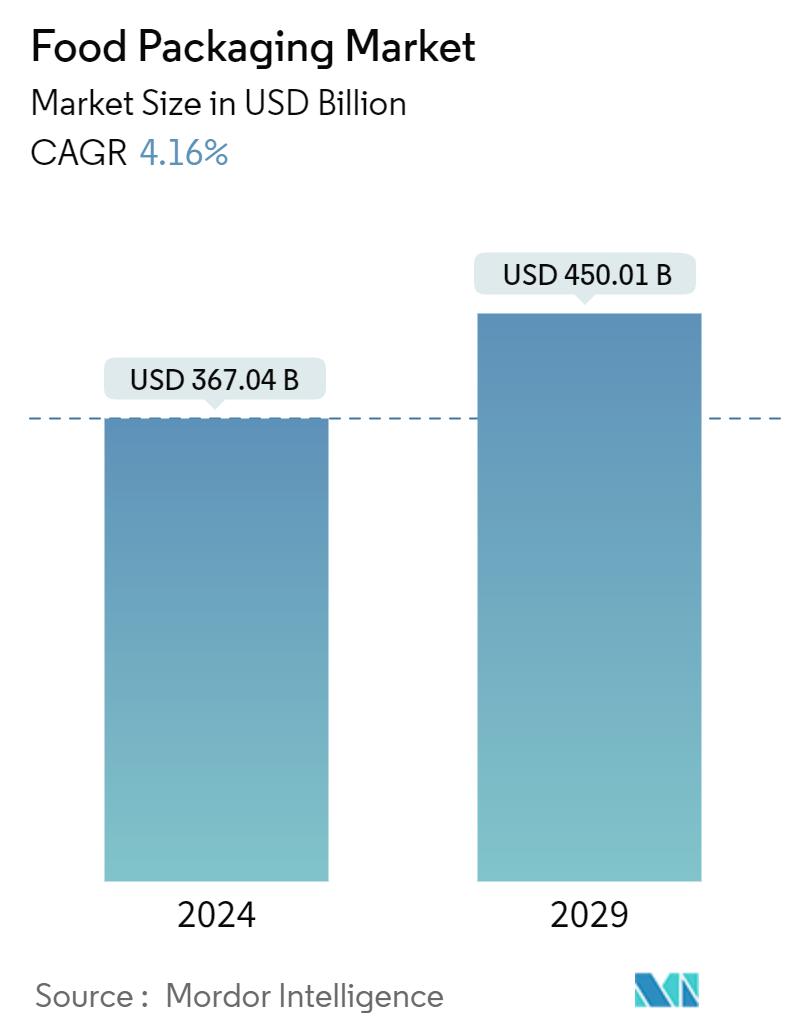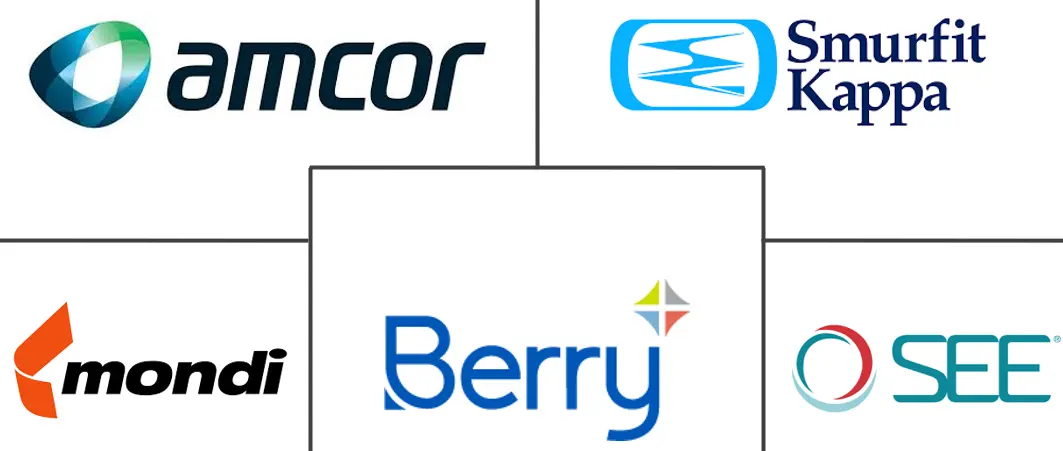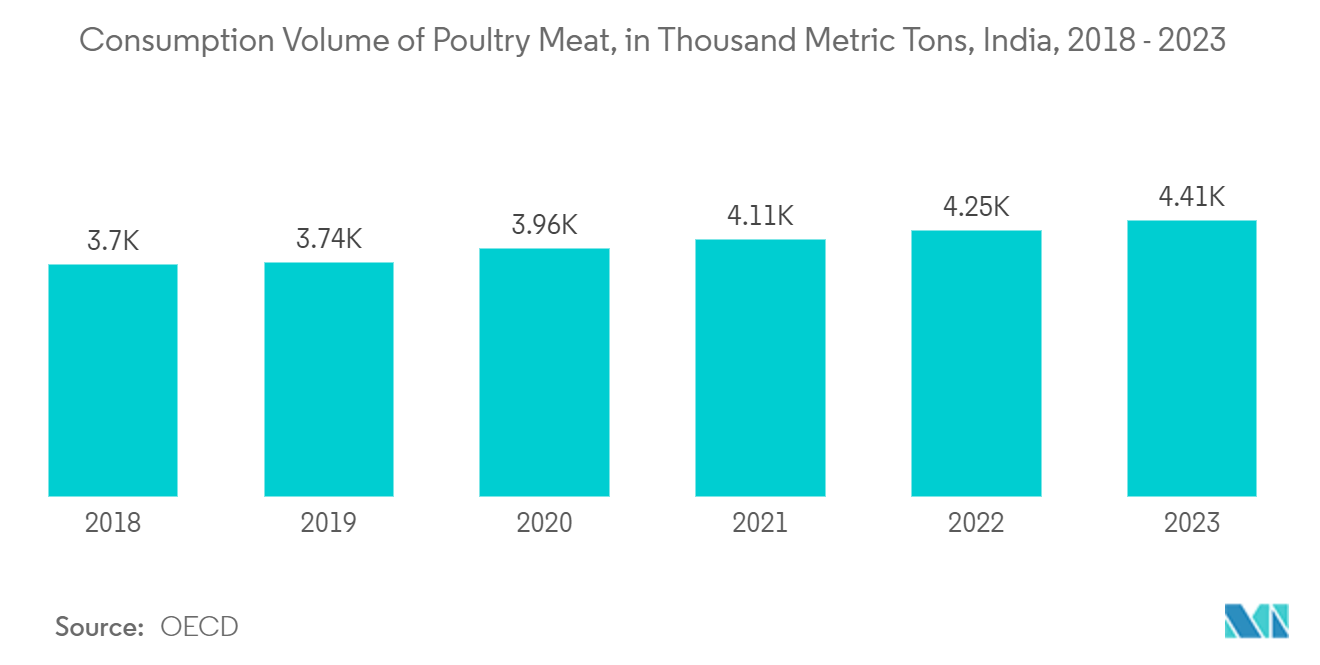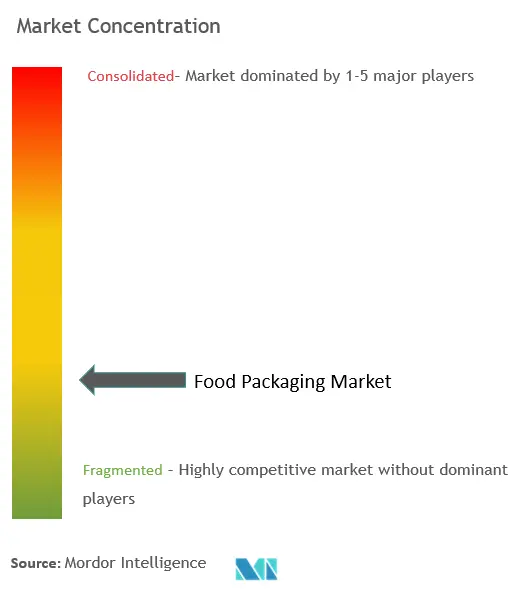Food Packaging Market Size

| Study Period | 2019 - 2029 |
| Market Size (2024) | USD 367.04 Billion |
| Market Size (2029) | USD 450.01 Billion |
| CAGR (2024 - 2029) | 4.16 % |
| Fastest Growing Market | Asia Pacific |
| Largest Market | North America |
Major Players
*Disclaimer: Major Players sorted in no particular order |
Food Packaging Market Analysis
The Food Packaging Market size is estimated at USD 367.04 billion in 2024, and is expected to reach USD 450.01 billion by 2029, growing at a CAGR of 4.16% during the forecast period (2024-2029).
- The food packaging industry has experienced significant growth in recent years, primarily driven by factors such as urbanization, a rising middle-income population, and an increase in disposable income. The demand for packaged food has been steadily climbing, leading to a surge in the need for efficient and sustainable packaging solutions.
- One of the primary factors influencing the trajectory of the food packaging market is the increasing demand for convenience. Urbanization, changing dietary preferences, and busy lifestyles are driving consumers toward convenient, ready-to-eat meals. Consequently, there is a growing preference for packaging solutions that offer portability, user-friendliness, and extended shelf life to the food.
- The growth of the food packaging industry offers significant opportunities but also highlights a critical concern of sustainability. The excessive use of plastic packaging has raised alarms about environmental damage and pollution. In response, the food packaging industry is increasingly prioritizing sustainable packaging solutions. Biodegradable materials, such as compostable plastics, plant-based packaging, and recycled materials, are gaining momentum.
- As a result, manufacturers are increasingly exploring eco-friendly alternatives to traditional plastic packaging, driven by both regulatory pressures and consumer demand for greener options. For instance, in June 2024, Saica Group and Mondelez collaboratively introduced a new paper-based product targeting multipack products for the confectionery, biscuits, and chocolate markets to meet the sustainability standards set by the Confederation of European Paper (CEPI). This packaging solution is suitable for heat-sealable packing processes and can be produced coated or uncoated.
- The COVID-19 pandemic heightened consumer awareness regarding product hygiene. Consequently, the emphasis on food protection, freshness, safety, and hygiene has increased, driving demand for improved food packaging solutions. The food packaging market encountered a multifaceted scenario during the pandemic. Initially, demand surged for shelf-stable and single-use packaging due to stockpiling and hygiene concerns. This increase, however, temporarily sidelined sustainability efforts. Moving forward, the market is expected to experience sustained growth, driven by the ongoing shift toward e-commerce and convenience foods, with a renewed focus on innovative, eco-friendly packaging solutions.
Food Packaging Market Trends
Poultry and Meat Products Expected to Drive Market Growth
- The rise of poultry and meat consumption worldwide is significantly driving demand for innovative food packaging solutions. Packaging plays an essential role in maintaining hygiene throughout the supply chain, from processing plants to consumers. Multi-layered, high-barrier packaging materials prevent contamination by bacteria and other pathogens, reducing the risk of foodborne illnesses. This is especially crucial for meat products as they are highly perishables. For instance, according to the OECD, the consumption of poultry meat in India reached 4,407.2 thousand metric tons in 2023 from 4,253.7 thousand metric tons in 2022.
- As the demand for poultry and meat rises, food packaging manufacturers are introducing new packaging. In May 2024, Tops, a subsidiary of Central Retail, launched eco-friendly meat packaging for its chilled meat sections. It is made from natural plant materials, emphasizes flavor and freshness retention, prioritizes safety, and is eco-conscious. It quickly decomposes, offering a sustainable alternative to traditional plastics.
- Supermarkets are increasingly adopting sustainable packaging for meat products. In May 2023, Tesco Ireland, a subsidiary of British supermarket giant Tesco, started using new packaging called “pillow packs” for its range of fresh mincemeat products. This packaging replaced the traditional plastic tray and film lid, resulting in a significant reduction in plastic usage. Such trends of shifting toward sustainable packaging are creating demand for flexible and rigid packaging for food products.
- The substantial rise in demand for meat products, coupled with a significant shift in meat consumption patterns toward premium-quality and fresh/chilled meat, has emerged as a prominent trend in consumer behavior. The growth in the consumption of meat is increasingly creating demand for various packaging products and is expected to continue over the forecast period.

Asia-Pacific to be the Fastest Growing Market
- The region's food packaging market is experiencing growth, driven by increased exports of fruits and vegetables. As urbanization accelerates in Asia-Pacific countries, the demand for innovative fruit and vegetable powders and pieces is rising. These novel ingredients are easily integrated by food processing companies, enhancing flavors and streamlining the cooking process. Notably, in countries like India, the surge in online food ordering is boosting the demand for packaged food boxes. Statics Indonesia indicates that China and Malaysia are the primary importers of Indonesian fruits. In 2023, Indonesia exported approximately 403.68 million kilograms of fruits to China. Besides China, Indonesia mainly exports fruits to other Southeast Asian countries, such as Malaysia, Thailand, and Vietnam.
- The demand for packaged food is increasing as consumers in Asia become increasingly interested in healthy meals. People desire higher-quality food, whether low-cost, mass-market, or premium, to help them live healthier and more fulfilled lives. Top health items, ranging from dried fruit and nuts to snacks and ready-to-eat packaged meals, are reduced in salt, fat, and sugar and have greater overall nutritional value. For many, this goes hand-in-hand with efforts to combat obesity, heart disease, and other disorders that have accompanied economic progress, increased income, and urbanization.
- Consumers across the region are increasingly seeking better variety, novelty, and higher quality in their food choices. While affluent markets prioritize health and quality, even consumers in lower-income brackets are moving away from price-centric decisions, showing a willingness to experiment with new brands. This shift has significantly enhanced growth prospects for food packaging manufacturers. Both large enterprises and smaller players in the packaging sector are now getting opportunities to tailor solutions to the preferences of today's predominantly urban and convenience-focused end-users. Although environmentally and socially responsible products are progressively gaining traction in several Asian markets, they are well-positioned for sustained success in meeting evolving consumer demands.
- In Singapore, the government is bolstering the food sector to enhance food security by ramping up meat production through non-animal sources. Singapore holds a prominent position in the APAC plant-based meat market. The nation's food manufacturers are intensifying efforts to fortify food security, backed by substantial governmental support. These government-backed initiatives aimed at boosting food production are poised to fuel demand for a range of food packaging solutions.
- In addition, Singapore has a stronger presence of domestic manufacturers dedicated to plant-based meat production, enhancing the nation's global market position. For instance, Next Gen Foods, an innovative startup known for its leading plant-based chicken brand, Tindle, recently secured a significant USD 100 million investment from key industry players. Shandi Global recently launched Singapore's "largest" plant-based chicken manufacturing facility, highlighting advancements in the sector.

Food Packaging Industry Overview
The food packaging market is fragmented, with the presence of a large number of vendors operating with extensive product offerings worldwide. Some of the major players in the market are Amcor PLC, Smurfit Kappa Group PLC, Mondi Limited, Sonoco Products, Berry Global Group, Ball Corporation, Tetra Pak, Schur Flexibles Group, Anchor Packaging Inc., Crown Holdings Inc., International Papers, WestRock, and Sealed Air Corp., among others. These players are witnessing strategic initiatives such as product launches, collaborations, mergers, acquisitions, and others.
- March 2024: Sealed Air Corporation (SEE) launched an innovative paper-based bottom web to help food processors and retailers reduce plastic usage and meet consumer demand for paper packaging. The new CRYOVAC brand Barrier Formable Paper, made from 90% FSC-certified fibers, can achieve a 77% reduction in plastic usage in bottom web packaging when replacing PET/PE webs, according to SEE.
- February 2024: Faerch Group, a manufacturer of rigid food packaging and an integrated recycling company, introduced its new Tumbler range for the foodservice market. This innovative range incorporates at least 30% post-consumer recycled (PCR) material. It offers various capacities and includes four standardized lid designs compatible with all tumblers, optimizing supply chains and enhancing user experience. The Tumbler range is designed for continuous recycling into new food packaging, ensuring safety and functionality.
- October 2023: Charoen Pokphand Foods Public Company Limited (CP Foods) collaborated with SCG Packaging PLC (SCGP) and SCG Chemicals PLC (SCGC) to develop sustainable and eco-friendly food packaging solutions. This collaboration, formalized through a memorandum of understanding (MoU), aims to innovate in pulp and polymer-based packaging with SCGP and green polymer-based plastic solutions with SCGC.
Food Packaging Market Leaders
-
Amcor Plc.
-
Smurfit Kappa Group plc.
-
Mondi Limited
-
Berry Global Group
-
Sealed Air Corp.
*Disclaimer: Major Players sorted in no particular order

Food Packaging Market News
- March 2024: Researchers at Panjab University's Institute of Forensic Science were granted an Indian patent for their biodegradable food packaging film. This innovative film, designed to replace conventional plastic packaging, is made from renewable, environmentally friendly materials. This patent encompasses the creation of a biodegradable food packaging film crafted from renewable, environmentally friendly materials designed for the storage and preservation of food items.
- November 2023: SIG launched its Packaging Development Center in Europe, located at its packaging plants in Linnich, Germany, with an investment of USD 10.93 million. This initiative aims to accelerate the development of innovative and sustainable packaging solutions, providing added value to its customers. The new center is equipped with state-of-the-art extrusion and finishing technologies, along with advanced quality measurement systems and testing equipment. It will significantly enhance packaging processability in serial production, system validation, and capacity for future digital technologies. As per company officials, alongside its existing co-creation and test-filling facilities for food and beverage products, the company can now produce carton sleeves, fill products in compliance with food hygiene regulations, and pack them on pallets. This end-to-end capability effectively transforms the company into a mini factory for packaging and the production of food and beverages.
Food Packaging Market Report - Table of Contents
1. INTRODUCTION
- 1.1 Study Assumptions and Market Definitions
- 1.2 Scope of the Study
2. RESEARCH METHODOLOGY
3. EXECUTIVE SUMMARY
4. MARKET INSIGHTS
- 4.1 Market Overview
-
4.2 Industry Attractiveness - Porter's Five Forces Analysis
- 4.2.1 Bargaining Power of Buyers/Consumers
- 4.2.2 Bargaining Power of Suppliers
- 4.2.3 Threat of New Entrants
- 4.2.4 Threat of Substitute Products
- 4.2.5 Intensity of Competitive Rivalry
- 4.3 Industry Value Chain Analysis
- 4.4 Assessment of the Impact of COVID-19 on the Market
5. MARKET DYNAMICS
-
5.1 Market Drivers
- 5.1.1 Demand for Convenience Foods in Developing Economies
- 5.1.2 Increasing Demand for Shelf-Life Extension of Foods Accelerating the Food Packaging Market
- 5.1.3 Trend of Small Households
-
5.2 Market Restraints
- 5.2.1 Stringent Regulations Pertaining to Food Packaging
6. MARKET SEGMENTATION
-
6.1 By Type of Material
- 6.1.1 Plastic
- 6.1.2 Metal
- 6.1.3 Glass
- 6.1.4 Paper and Paperboard
-
6.2 By Packaging Type
- 6.2.1 Rigid
- 6.2.2 Semi Rigid
- 6.2.3 Flexible
-
6.3 By Product Type
- 6.3.1 Cans
- 6.3.2 Converted Roll Stock
- 6.3.3 Gusseted Box
- 6.3.4 Corrugated Box
- 6.3.5 Boxboard
- 6.3.6 Other Packaging Types (Pouches and bottles)
-
6.4 By Application
- 6.4.1 Dairy Products
- 6.4.2 Poultry and Meat Products
- 6.4.3 Fruits & Vegetables
- 6.4.4 Bakery & Confectionery
- 6.4.5 Other Applications (Seafood, Convenience Food, Snacks and Side Dishes, Sauces, Dressings, and Condiments)
-
6.5 By Geography
- 6.5.1 North America
- 6.5.1.1 United States
- 6.5.1.2 Canada
- 6.5.2 Europe
- 6.5.2.1 Germany
- 6.5.2.2 France
- 6.5.2.3 United Kingdom
- 6.5.2.4 Spain
- 6.5.2.5 Italy
- 6.5.2.6 Rest of Europe
- 6.5.3 Asia-Pacific
- 6.5.3.1 China
- 6.5.3.2 Japan
- 6.5.3.3 India
- 6.5.3.4 Australia
- 6.5.3.5 Rest of Asia-Pacific
- 6.5.4 Rest of the World
7. COMPETITIVE LANDSCAPE
-
7.1 Company Profiles
- 7.1.1 Amcor PLC
- 7.1.2 Smurfit Kappa Group PLC
- 7.1.3 Mondi Limited
- 7.1.4 Berry Global Group
- 7.1.5 Ball Corporation
- 7.1.6 Tetra Pak
- 7.1.7 Schur Flexibles Group
- 7.1.8 Anchor Packaging Inc.
- 7.1.9 Crown Holdings Inc.
- 7.1.10 International Papers
- 7.1.11 WestRock
- 7.1.12 Sealed Air Corp.
- 7.1.13 Graham Packaging Company Inc.
- *List Not Exhaustive
8. INVESTMENT ANALYSIS
9. FUTURE OF THE MARKET
** Subject To AvailablityFood Packaging Industry Segmentation
Food packaging encompasses the materials and containers used to wrap, protect, preserve, transport, and display food products. It is essential in the food supply chain to ensure food safety and hygiene, extend shelf life, and maintain food quality, convenience, and consumer information.
The food packaging market is segmented by type of material (plastic, metal, glass, and paper & paperboard), packaging type (rigid, semi-rigid, flexible), product type (cans, converted roll stock, gusseted box, corrugated box, and boxboard), application (dairy products, poultry & meat products, fruits & vegetables, and bakery & confectionery) and geography (North America, Europe, Asia-Pacific, and Rest of the World). The market sizes and forecasts are provided in terms of value (USD) for all the above segments.
| By Type of Material | Plastic | |
| Metal | ||
| Glass | ||
| Paper and Paperboard | ||
| By Packaging Type | Rigid | |
| Semi Rigid | ||
| Flexible | ||
| By Product Type | Cans | |
| Converted Roll Stock | ||
| Gusseted Box | ||
| Corrugated Box | ||
| Boxboard | ||
| Other Packaging Types (Pouches and bottles) | ||
| By Application | Dairy Products | |
| Poultry and Meat Products | ||
| Fruits & Vegetables | ||
| Bakery & Confectionery | ||
| Other Applications (Seafood, Convenience Food, Snacks and Side Dishes, Sauces, Dressings, and Condiments) | ||
| By Geography | North America | United States |
| Canada | ||
| By Geography | Europe | Germany |
| France | ||
| United Kingdom | ||
| Spain | ||
| Italy | ||
| Rest of Europe | ||
| By Geography | Asia-Pacific | China |
| Japan | ||
| India | ||
| Australia | ||
| Rest of Asia-Pacific | ||
| By Geography | Rest of the World |
Food Packaging Market Research FAQs
How big is the Food Packaging Market?
The Food Packaging Market size is expected to reach USD 367.04 billion in 2024 and grow at a CAGR of 4.16% to reach USD 450.01 billion by 2029.
What is the current Food Packaging Market size?
In 2024, the Food Packaging Market size is expected to reach USD 367.04 billion.
Who are the key players in Food Packaging Market?
Amcor Plc., Smurfit Kappa Group plc., Mondi Limited, Berry Global Group and Sealed Air Corp. are the major companies operating in the Food Packaging Market.
Which is the fastest growing region in Food Packaging Market?
Asia Pacific is estimated to grow at the highest CAGR over the forecast period (2024-2029).
Which region has the biggest share in Food Packaging Market?
In 2024, the North America accounts for the largest market share in Food Packaging Market.
What years does this Food Packaging Market cover, and what was the market size in 2023?
In 2023, the Food Packaging Market size was estimated at USD 351.77 billion. The report covers the Food Packaging Market historical market size for years: 2019, 2020, 2021, 2022 and 2023. The report also forecasts the Food Packaging Market size for years: 2024, 2025, 2026, 2027, 2028 and 2029.
What are the emerging technologies used in Food Packaging to enhance consumer experience?
The emerging technologies used in Food Packaging to enhance consumer experience are a) Interactive packaging with QR codes b) Printed recipes c) Temperature indicators for consumer engagement
What are the emerging technologies used in Food Packaging to enhance consumer experience?
The emerging technologies used in Food Packaging to enhance consumer experience are a) Interactive packaging with QR codes b) Printed recipes c) Temperature indicators for consumer engagement
Food Packaging Industry Report
The food packaging industry is experiencing robust growth, fueled by evolving consumer habits and a surge in demand for convenience foods. Innovations like flexible packaging are leading the market, offering lightweight, compact solutions that cater to the shift from rigid packaging, promising to amplify this segment further. The industry is also adapting to the demand for extended shelf-life and freshness through advanced techniques like intelligent packaging. Moreover, there's a significant push towards sustainable and eco-friendly options, with bio-based plastics becoming increasingly popular. The Asia-Pacific region stands out as a rapidly expanding market, driven by higher disposable incomes and a preference for quality food. These food packaging industry trends reflect a move towards more innovative, sustainable, and consumer-centric solutions, aligning with global shifts in food consumption and lifestyle changes. For detailed insights, Mordor Intelligence™ provides comprehensive analysis on market share, size, revenue growth, and forecasts, available as a free report PDF download, highlighting the dynamic landscape and future outlook of the food packaging industry.



